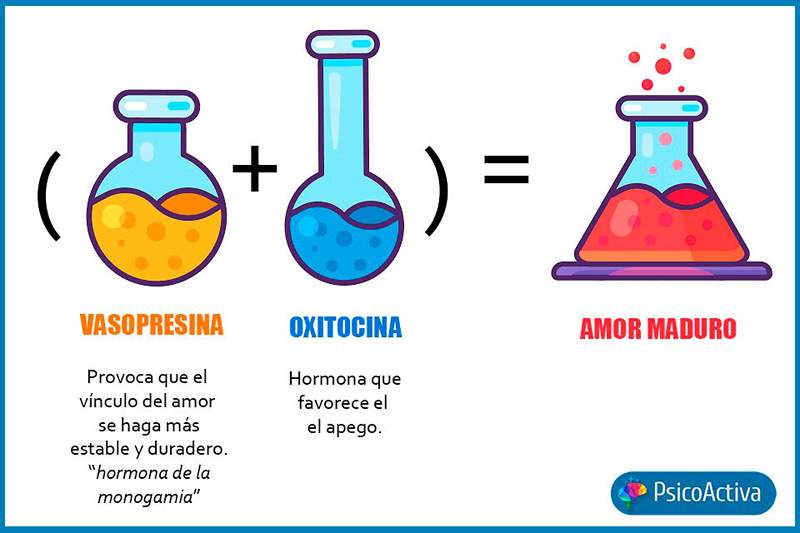Oxytocin and its effects

- 2030
- 248
- Austin Stokes
The oxytocin It is a hormone produced by the hypothalamus and secreted by the pituitary gland, a stew -size structure at the base of the brain.
Oxytocin is also called as the "Hormone of happiness" or "love hormone", since it is activated to give way to a wide variety of physical and psychological effects related to feelings of affection, trust, fidelity, well -being and even calm.
It is usually released in the moments when we do sports, we play, we dance, sing, kiss or give a hug, among others.
Content
Toggle- Oxytocin in women
- Oxytocin in men
- Problems in oxytocin production
- References
Oxytocin in women
The oxytocin It is a particularly important hormone for women. Play a very significant role in the childbirth process. This hormone causes uterine contractions during childbirth and helps the uterus recover after the same. When a baby sucks his mother's chest, stimulation causes an oxytocin release, which in turn orders the body to produce milk for the baby.
Oxytocin also promotes the link between mother and child. Laboratory studies show that female rats find no interest in puppies when they are still virgin. But once they give birth, the brain is transformed, and then the irresistible puppies find. And similar findings are observed in humans.
A 2007 study published in the journal Psychological Science was observed that the higher the oxytocin levels in the mother during the first trimester of pregnancy, the more likely they were involved in union behaviors with them such as singing or bathing their baby.

Oxytocin in men
In men, as in women, Oxytocin facilitates emotional union and affective bond. In an experiment carried out in 2012 in which oxytocin was administered through a nasal spray to parents of children of 5 months of age, it was observed that they played for longer than those parents who did not receive the hormone.
Another study found that men with a stable partner, if oxytocin in aerosol was administered, were less interested in other attractive women than men who did not receive any oxytocin. In single men they did not see any significant effect of the hormone, which suggests Oxytocin can function as a reinforcement of fidelity For individuals who are already united with a woman.

In another study, published in PNAS in 2010, participants were given a dose of oxytocin and were asked to write about their mothers. Those who had safe relationships described that they had a very positive relationship with their mothers (more than before taking the hormonal dose). Those who had problematic relationships instead described the relationship with their mothers more negatively than at the beginning. Thus, we see that the hormone can Help in the formation of social memory, According to study researchers, so oxytocin seems to strengthen or intensify existing associations, whether good or bad.
According to researchers, what oxytocin is doing in the brain is that the most relevant social information is more relevant. Areas of the brain involved in the processing of social information are connected, whether places, faces, sounds or odors, which helps link those areas for the brain reward system.
 Our capacity for choice
Our capacity for choice Problems in oxytocin production
Sometimes oxytocin levels may be higher and lower, but research has not yet found any explanation about these differences.
Men with high levels of oxytocin sometimes develop benign prostatic hyperplasia, or the extension of the prostate gland. This condition can cause urinary problems.
In women, lack of sufficient oxytocin can prevent milk decline and reflect that breastfeeding is difficult.
On the other hand, some people With autism or with autistic spectrum disorders they have low oxytocin levels. Low oxytocin levels have also been related to depression disorders, but the use of oxytocin to treat these conditions has not yet been studied.
Stress hormone: cortisol
References
- Bloom, f.AND. I lazerson, to. (1988). Brain, Mind, and Behavior. Nova York: Freeman and Company.
- Bradford, h.F. (1988). Fundamentals of neurochemistry. Barcelona: Labor.
- Carlson, n.R. (1999). Behavior Physiology. Barcelona: Ariel Psychology.
- Of April, to.; Ambrosio, e.; Blas, M.R.; Caminero, a.; From Paul, J.M. I Sandoval, and. (EDS) (1999). Biological basis of behavior. Madrid: Sanz and Torres.
- Kandel, e.R.; Shwartz, J.H. I Jesell, T.M. (eds) (1997) Neuroscience and behavior. Madrid: Prentice Hall.
- https: // www.Medigraphic.com/pdfs/ginobsmex/gom-2014/gom147f.PDF
- https: // www.Scielo.BR/J/RLAE/A/RVCQ6KDG65JFXSNMYFYCTRQ/?format = pdf & lang = is
- « What happens to our brain when we fall in love?
- Screen apnea when screens affect our breathing and well -being »

